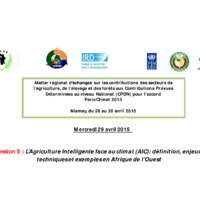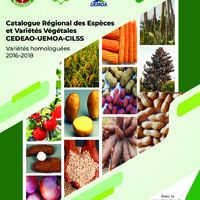Recherche
6 items
Acquis du CILSS dans le domaine de la recherche et de l’innovation
Dans leurs activités de recherche, les experts du CILSS sont impliqués dans plusieurs initiatives régionales et internationales dans lesquelles leurs contributions ont permis d’accroître la visibilité de l’institution et de la positionner aujourd’hui au cœur de plusieurs initiatives internationales sur la
sécurité alimentaire et les changements climatiques.
Les résultats de ces travaux ont été valorisés sous forme d’articles dans les revues scientifiques, de thèses de doctorat et de masters, de chapitres dans des ouvrages, de présentations à des conférences internationales ou de conférences débats.
Annuaire des diplômés
De sa création à 2023, le CRA a formé 1 757 diplômés dont 909 Techniciens Supérieurs, 310 Ingénieurs et 538 Masters dans les domaines de la Sécurité Alimentaire et Nutritionnelle, la Gestion des Ressources Naturelles et la Maîtrise de l’Eau dans un contexte de changement climatique.Il a également participé au perfectionnement de plus de 9 000 cadres sahéliens et ressortissants d’autres régions d’Afrique. Le succès de ces formations constitue un réel motif de satisfaction pour le CILSS et ses partenaires, surtout que la demande de cette prestation dépasse l’espace sahélien pour toucher désormais d’autres pays de la CEDEAO, de l’Afrique Centrale et Australe.
Atelier régional d’échanges sur les contributions des secteurs de l’agriculture, de l’élevage et des forêts aux Contributions Prévues Déterminées au niveau National (CPDN) pour l’accord Paris Climat 2015
Session 5: L’Agriculture Intelligente face au climat (AIC): définition, enjeux,
techniques et exemples en Afrique de l’Ouest
Catalogue régional des espèces et variétés végétales CEDEAO-UEMOA-CILSS : Variétés homologuées2016-2018
Aux termes des dispositions des articles 9.1 du règlement semencier C/REG.4/05/2008 de la CEDEAO et 80.1 du règlement semencier REGL.N°03/2009/CM de l'UEMOA, le Catalogue Ouest Africain des Espèces et Variétés Végétales (COAfEV/CEDEAO) ou le Catalogue Régional des Espèces et Variétés Végétales (CREVU/UEMOA), ci-après désigné par « Catalogue Régional CEDEAO-UEMOA-CILSS des Espèces et Variétés Végétales », est constitué de la liste limitative des variétés dont les semences peuvent être produites et commercialisées sur le territoire des 17 pays de cet espace. Ce Catalogue contient donc l'ensemble des variétés de la liste A des catalogues nationaux. Ce Catalogue remplace le Catalogue Ouest Africain des Espèces et Variétés Végétales (COAfEV) édité en 2018. Il porte sur les variétés des 11 cultures prioritaires que sont : le riz, le maïs, le sorgho, le mil, l'arachide, le niébé, le manioc, l'igname, la pomme de terre, la tomate et l'oignon. Les variétés de ce catalogue ont été retenues sur la base de la disponibilité des informations essentielles de DHS et VATE. Les caractères variétaux présentés le sont à titre informatif, pour faciliter le choix des utilisateurs
Expanding capacity for translating seasonal climate forecasts into actionable information for agriculture and water sectors in West Africa: Lessons learnt and way forward
With climate change and variability posing challenges to sub-Saharan Africa’s development sectors, weather and climate information services are crucial for building climate-resilient development pathways (Hansen et al., 2022). Seasonal forecasts in particular provide prospective information about the upcoming season, with a particular focus on precipitation and temperature (Guido et al., 2020; Hansen et al., 2011). However, a direct and linear translation of the seasonal forecasts to sector-specific information such as water resources and agriculture can lead to inaccurate recommendations. Integrating seasonal forecast data into biophysical models can enable the generation of sector-relevant actionable information that can improve the decision-making (Hansen, 2005; Houngnibo et al 2023). This would contribute to a better understanding of the impacts of climate forecasts in the water and agriculture sectors, among others, thereby facilitating more informed decision-making.
Regional operational meteorological centers, including AGRHYMET Regional Climate Center for West Africa and the Sahel (AGRHYMET CCR-AOS), are regularly producing seasonal climate forecasts to help inform adaptation decision-making at various levels. As a Regional Climate Center, AGRHYMET CCR-AOS coordinates the development of consensus seasonal forecasts through Regional Climate Outlook Forums (RCOF), which bring together experts from National Meteorological and Hydrological Services (NMHSs), basin organizations, and global climate centers. AGRHYMET CCR-AOS has proposed a new approach to translate seasonal forecasts into sector-specific actionable information for agriculture and water sectors through crop and hydrological models. This is referred to as extended seasonal forecasts in agriculture and water sectors (Houngnibo et al 2023).
As part of AICCRA West Africa cluster activities, AGRHYMET has capacitated NMHSs in West Africa and the Sahel on this approach as a first step towards extended and widespread uptake and utilisation in NMHSs in the region. The capacity building event took place in Ouagadougou, Burkina-Faso from August 7th to 11th, 2023. The objective was to enhance the capacity of NMHSs to use new tools that combine seasonal forecasts with impact models in the agriculture and water resources sectors. This Info Note documents the process, key insights and lessons from the regional capacity building for translating seasonal forecasts into actionable information for agriculture and water sectors in West Africa for a better-informed policy and action decision making.
Synergies between the Food System Resilience Program (FSRP) and the Accelerating Impacts of CGIAR Climate Research for Africa (AICCRA) in West Africa: Implementation domains for cross-fertilization
The Food System Resilience Program (FSRP) and the Accelerating Impacts of CGIAR Climate Research for Africa (AICCRA) are two World Bank’s International Development Association (IDA)-funded projects that include West Africa and the Sahel as intervention region. While the first phase of AICCRA is planned for 2021-2023 with a possible 5-years additional financing from 2024 (Zougmoré et al., 2023), the FSRP is a multi-phase long-term commitment program required to build sustainable regional mechanisms and institutions with sufficient substance at a regional level. This multi-phase approach will enable a set of countries with varying degrees of readiness to adopt consistent approaches and accede to regional systems at appropriately differential speeds. Phasing the accession of countries according to their readiness will allow regional mechanisms to operate with maximum effectiveness. While FSRP is aligned to the Economic Community of West Africa States Agricultural Policy (ECOWAP) as the main framework for agricultural transformation and regional integration, and implemented through three major regional organizations, i.e., Economic Community of West African States (ECOWAS), Permanent Interstate Committee for Drought Control in the Sahel (CILSS)’s specialized center AGRHYMET Regional Climate Center and the West and Central African Council for Agricultural Research and Development (CORAF), AICCRA builds on 50 years of CGIAR climate research innovations, especially on the achievements of the CGIAR Research Program on Climate Change, Agriculture and Food Security (CCAFS) to contribute developing a climate-smart African future driven by science and innovation in agriculture. More specifically, AICCRA works to upscale and make climate information services and climate-smart agriculture technologies more accessible to millions of smallholder farmers across Africa. At the same time, FSRP aims to strengthen regional food system risk management, improve the sustainability of the productive base in targeted areas and to develop regional agricultural markets.
In view of the complementarity between the two projects, i.e., AICCRA being a potential provider of scientifically evidence-based innovations, tools and approaches, while the FSRP is a potential user of these knowledge and information, and at the same time both are working on the common topic of supporting resilient agriculture and food systems, the World Bank has fostered active synergy between the two projects since their design phases, in a way to promote a win-win cross-fertilization. Since the commencement of FSRP implementation, clear Program of Work and Budget has been developed, with strategic areas of collaboration in a formal document that will serve as implementing guide to both projects and inform other WB operations in IDA countries and regions in Africa and beyond. This Info Note synthesizes and analyses collaboration domains for synergy and cross-fertilization between AICCRA and FSRP, with focus on the latter’s two regional components led by CILSS/AGRHYMET and CORAF.


